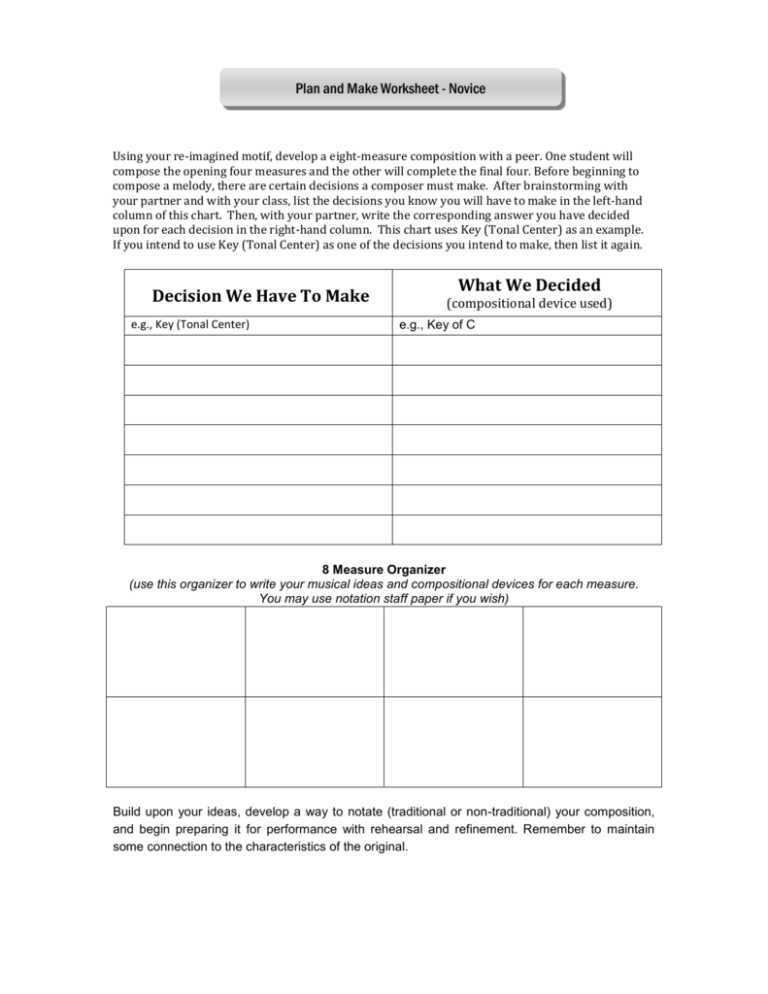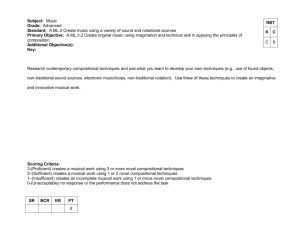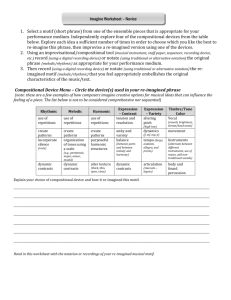Decision We Have To Make What We Decided
advertisement

Plan and Make Worksheet - Novice Using your re-imagined motif, develop a eight-measure composition with a peer. One student will compose the opening four measures and the other will complete the final four. Before beginning to compose a melody, there are certain decisions a composer must make. After brainstorming with your partner and with your class, list the decisions you know you will have to make in the left-hand column of this chart. Then, with your partner, write the corresponding answer you have decided upon for each decision in the right-hand column. This chart uses Key (Tonal Center) as an example. If you intend to use Key (Tonal Center) as one of the decisions you intend to make, then list it again. Decision We Have To Make e.g., Key (Tonal Center) What We Decided (compositional device used) e.g., Key of C 8 Measure Organizer (use this organizer to write your musical ideas and compositional devices for each measure. You may use notation staff paper if you wish) Build upon your ideas, develop a way to notate (traditional or non-traditional) your composition, and begin preparing it for performance with rehearsal and refinement. Remember to maintain some connection to the characteristics of the original. Plan and Make Worksheet - Intermediate Using your re-imagined passage, develop a sixteen-measure composition with a peer. One student will compose the opening eight measures and the other will complete the final eight. Before beginning to compose a melody, there are certain decisions a composer must make. After brainstorming with your partner and with your class, list the decisions you know you will have to make in the left-hand column of this chart. Then, with your partner, write the corresponding answer you have decided upon for each decision in the right-hand column. This chart uses Key (Tonal Center) as an example. If you intend to use Key (Tonal Center) as one of the decisions you intend to make, then list it again. Decision We Have To Make e.g., Key (Tonal Center) What We Decided (compositional device used) e.g., Key of C 16 Measure Organizer (use this organizer to write your musical ideas and compositional devices for each measure. You may use notation staff paper if you wish) Build upon your ideas, develop a way to notate (traditional or non-traditional) your composition, and begin preparing it for performance with rehearsal and refinement. Remember to maintain some connection to the characteristics of the original. Plan and Make Worksheet - Proficient Based upon your re-imagined musical theme, develop you new composition for each phrase while maintaining the stylistic nature of each piece. 8 Measure Organizer for theme 1 ___________________________________ ___________________________________ (name of original piece) (style of this piece) (use this organizer to write your musical ideas and compositional devices for each measure. You may use notation staff paper if you wish) 8 Measure Organizer for theme 2 ___________________________________ ___________________________________ (name of original piece) (style of this piece) (use this organizer to write your musical ideas and compositional devices for each measure. You may use notation staff paper if you wish) Build upon your ideas, develop a way to notate (traditional or non-traditional) your composition, and begin preparing it for performance with rehearsal and refinement. Remember to maintain some connection to the historical/stylistic characteristics of from each of the original themes. Plan and Make Worksheet - Accomplished ___________________________________ (name of original piece) ___________________________________ (cultural background of this piece) Develop your re-imagined musical theme into a performable composition maintaining the cultural characteristics of the piece. Consider the following categories to guide your plan. Then produce a notated version (traditional or non-traditional) that clearly reflects that music performed. Ideas & Content—(theme, expression, dynamics)—varied in a way to keep the listener’s attention; Organization—(form) —Clear recognizable patterns and sequence; guides listener’a anticipation; Flow—(melody)—clear melodic direction with performable intervals Fluency—(rhythm)—functional and performable—flows with a forward feel Conventions—(symbols, accurate manuscript)—few errors; easy to read Explain or diagram your plan for putting your musical ideas. You may use score paper for traditional notation. Begin preparing the piece for performance with rehearsal and refinement. Plan and Make Worksheet - Advanced _____________________________________________________ (name of original piece) Develop your new composition to be performed. Work to maintain the integrity of the original piece while reinventing the music by altering characteristics of the piece. Consider the following categories to guide your plan. Then produce a notated version (traditional or non-traditional) that clearly reflects that music performed. Ideas & Content—(theme, expression, dynamics)—varied in a way to keep the listener’s attention; Organization—(form) —Clear recognizable patterns and sequence; guides listener’a anticipation; Flow—(melody)—clear melodic direction with performable intervals Fluency—(rhythm)—functional and performable—flows with a forward feel Conventions—(symbols, accurate manuscript)—few errors; easy to read Explain or diagram your plan for putting your composition. You must also score paper for with traditional notation, although non-traditional notation may be incorporated.







